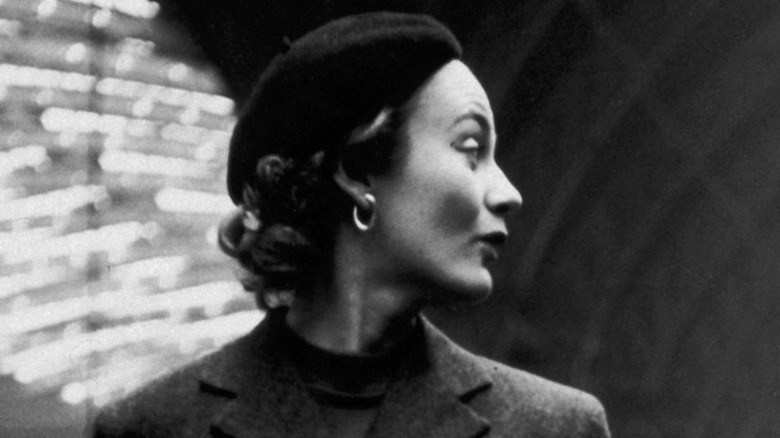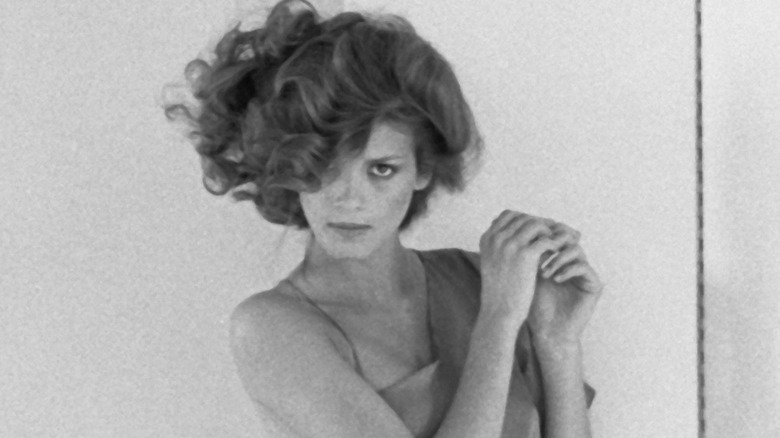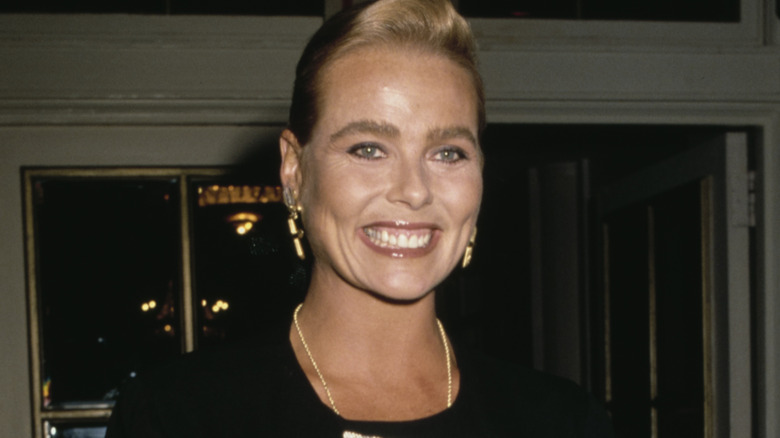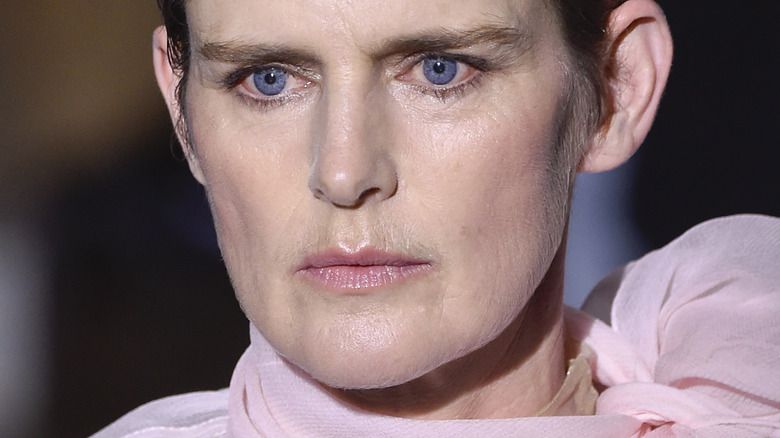Supermodels Who've Passed Away
Supermodels have been the subject of public attention for far longer than most people realize. While many recall the age of supermodels from the 1980s and '90s featuring the likes of Claudia Schiffer, Cindy Crawford, and many more, supermodels have been around since the mid-20th century. Regardless of the decade that made them famous, supermodels have long dominated the zeitgeist via global recognition.
Essentially, that's what a supermodel is: a model known throughout the world, and there are hundreds of them these days. They are often known for commercial and haute couture modeling, with many participating in high-profile fashion events, including the Paris, New York, London, and Milan Fashion Weeks. Schiffer once said, "In order to become a supermodel, one must be on all the covers all over the world at the same time so that people can recognize the girls." In the same interview with Fivetonine, she also said it was no longer possible to become a supermodel, and "Supermodels like we once were don't exist anymore" (via London Evening Standard).
The supermodel hasn't gone away despite her claim in 2007, but many supermodels have died over the years. Sadly, most supermodels tend to live fast and die young — often tragically. Over the years, several prominent supermodels have passed away, each impacting the fashion industry. While many supermodels are no longer walking the catwalk in today's highest fashion, these women made a mark on the industry and have since died.
The following article includes mentions of suicide, alcohol and drug addiction, and eating disorders.
Lisa Fonssagrives
Lisa Fonssagrives isn't a name many people know today outside the fashion industry, but through much of the mid-20th century, she was the biggest thing in fashion. She is considered to be the world's first supermodel, and she had a remarkable career. Fonssagrives was born in Sweden in 1911, and she initially studied dancing before transitioning to modeling in the 1930s. By the late-'30s, Fonssagrives was appearing in Paris Vogue.
Fonssagrives moved to the United States in 1939 and was already well known around the world. Throughout the 1940s, she appeared on the covers of Time, Vanity Fair, Town & Country, and Vogue and was well compensated. According to The New York Times, by the late 1940s, Fonssagrives was earning $40 an hour while other models were making between $10 and $25. Her collaborations with her photographer husband, Irving Penn, have become iconic.
Fonssagrives was humble about her status as the "It girl" of her generation, calling attention to the clothes in an interview with Time. "It is always the dress; it is never, never the girl. I'm just a good clothes hanger" (via The New York Times). Fonssagrives continued modeling into her forties when most women had long since quit the industry. She continued modeling into the mid-1950s and designed clothes before becoming a sculptor. Fonssagrives is remembered today as the world's first supermodel, though she may not have been called that during her lifetime. She died from pneumonia on February 6, 1992, at the age of 80.
Gia Carangi
While Lisa Fonssagrives is considered to be the world's first supermodel, the first modern supermodel is arguably Gia Carangi. Carangi began her career in modeling in 1977, when she was discovered in a Philadelphia, Pennsylvania, hair salon by Sondra Scerca. She soon moved to New York City, New York, and signed with Wilhelmina Models. Her meteoric rise in the fashion industry saw Carangi gracing the covers of Vogue and Cosmopolitan for the next few years, earning as much as $10,000 a day on modeling shoots (via Vogue).
Carangi's rise was swift, but so too was her fall. In 1981, she moved back to Philadelphia in an effort to overcome her cocaine addiction. Her drug use was known among her industry peers and was mostly tolerated, but her partying lifestyle caught up to her fairly quickly. She began taking heroin, and photographers noticed the track marks on her arms and a scab on her hand where she often injected the drug.
Carangi spent the next few years attempting to recover through rehabilitation, followed by industry comebacks. Unfortunately, she underwent several cycles of this behavior, and by late 1985, she was diagnosed with AIDS. That same year, Carangi was in and out of rehab and was hospitalized numerous times. Carangi was one of the first high-profile women to die of AIDS in the United States when she died on November 18, 1986. Her life story was dramatized in the 1998 Angelina Joe biopic, "Gia."
If you or anyone you know needs help with addiction issues, help is available. Visit the Substance Abuse and Mental Health Services Administration website or contact SAMHSA's National Helpline at 1-800-662-HELP (4357).
Margaux Hemingway
Margaux Hemingway began modeling in 1972 when she was 18, and by 1975, she signed with Fabergé's Babe perfume. Her contract was valued at a then-unrivaled $1 million ($5.5 million in 2022). For the next few years, she was featured on the covers of numerous magazines around the world, including Time, which dubbed her one of the "New Beauties" in fashion. In 1976, she made the leap to feature films, premiering alongside her sister Mariel in the cult classic, "Lipstick."
That film didn't blow anyone away at the time, but that didn't deter her from continuing to act, and throughout her career, she appeared in over a dozen feature films and TV movies. Hemingway continued working as a fashion model while building her acting resume. She spent her adolescence and much of her adult life addicted to various drugs and alcohol, leading to issues with weight gain and loss. She sought help at rehabilitation clinics and attempted a comeback by gracing the cover of Playboy in 1990.
Hemmingway's life was filled with ups and downs, resulting in various issues, including numerous addictions and depression. On July 1, 1996, Hemingway's already decomposing body was discovered in her Santa Monica, California apartment. She died by suicide from a drug overdose at the age of 41. Her actual date of death isn't precise, though her death record lists the day her body was found as the day she died.
If you or anyone you know is having suicidal thoughts, please call the National Suicide Prevention Lifeline by dialing 988 or by calling 1-800-273-TALK (8255).
Nafisa Joseph
Nasifa Joseph began modeling at an early age, but it wasn't until she entered the Femina Miss India pageant in 1997 that she became famous. Joseph was one of the youngest contestants in the pageant's history, being only 19 at the time. Despite her inexperience, Joseph won the pageant and went on to compete in the Miss Universe pageant later that year. She was a finalist but didn't secure the title of Miss Universe in 1997.
Following her pageant days, Joseph began working for MTV India as a judge for "VJ Hunt." She spent the next five years running "MTV House Full." She appeared in various television series, including the Indian version of "Charlie's Angels," which is called "C.A.T.S." Joseph was engaged to be married to Gautam Khanduja, an auto parts dealer. The couple planned on marrying in mid-2004, but a few weeks before the wedding, Joseph died by suicide.
Joseph's body was found by her mother on July 29, 2004, and questions persisted as to why she ended her life. According to India Daily, Joseph's fiancé was already married and shared a joint bank account with his wife. Allegations were made against Khanduja, with Joseph's family pointing the finger in his direction for being responsible for her death. This resulted in Kanduja's arrest for abatement to suicide, and a trial, which was stayed by the court and has since not been adjudicated.
If you or anyone you know is having suicidal thoughts, please call the National Suicide Prevention Lifeline by dialing 988 or by calling 1-800-273-TALK (8255).
Luisel and Eliana Ramos
Luisel and Eliana Ramos were sisters who got into modeling alongside one another, appearing in their native Uruguay. They also worked in various places outside their home country, including Mexico and Japan. Both women worked for a short time but managed to make an impact on the industry. Sadly, the sisters died within six months of each other, completely devastating their family while highlighting the dangers of the industry.
On August 2, 2006, Luisel walked the catwalk at an event during Montevideo Fashion Week. She collapsed on her way off the catwalk and died. The cause of death was determined to be heart failure, likely brought on by anorexia nervosa; she was 22. According to her father, Luisel hadn't eaten for days and subsisted on a diet of lettuce and diet cola for three months before her death. Eliana continued modeling after her sister's death but died six months later.
Eliana was 18 when she died from a heart attack on February 13, 2007. She was visiting her grandparents in Montevideo, Uruguay, when she was found dead in their home. Her death came so soon after her sisters, leading many in the industry to suggest an eating disorder was the cause of her heart attack. Their deaths resulted in an industry change, with Madrid and Milan fashion bosses setting a minimum BMI for their models (via Daily Mail).
If you need help with an eating disorder, or know someone who is, help is available. Visit the National Eating Disorders Association website or contact NEDA's Live Helpline at 1-800-931-2237. You can also receive 24/7 Crisis Support via text (send NEDA to 741-741).
Ruslana Korshunova
Ruslana Korshunova was discovered in 2003 when she was 15, thanks to a photograph of her German language club making the papers (via Daily News). Debbie Jones of Models 1 spotted the picture while aboard a flight and became determined to find her. Jones told British Vogue, "I saw her by chance, and she looked like something out of a fairy tale! We had to find her, and we searched high and low until we did! She's really incredible, with feline features and timeless beauty."
Jones found Korshunova, and before long, she was modeling for nearly every fashion publication in circulation, including various versions of Vogue, Elle, and many more. Korshunova modeled for less than five years, having died on June 28, 2008, at the age of 20. Her death was suspicious due to the circumstances surrounding her demeanor and apartment around the time she died. Korshunova plummeted from her ninth-floor balcony, which showed no signs of struggle.
This led authorities to assume she died by suicide, but her family and friends weren't convinced. Journalist Peter Pomerantsev believed her death was related to an organization called Rose of the World, which she'd been a part of for three months leading up to her death. He noted the dehumanizing treatment of its members and believed the "cult" responsible. Regardless, barring any evidence to the contrary, Korshunova's death was ruled a suicide.
If you or anyone you know is having suicidal thoughts, please call the National Suicide Prevention Lifeline by dialing 988 or by calling 1-800-273-TALK (8255).
Lucy Gordon
Lucy Gordon began modeling while in high school, and before long, she was a featured model for CoverGirl. Gordon modeled for several companies, including Ann Taylor Loft, Christian Dior, GAP, and others, while also gracing the covers of Glamour in 1998 and Elle and D in 1999. While she was discovered as a model and had a successful career in that industry, Gordon used it as a springboard to launch her acting career.
Gordon's feature film debut came in 2001 when she played Sarah in "Perfume." This was followed by appearances in "The Russian Dolls," "Spider-Man 3," and several other films, two of which were released posthumously. Gordon died by suicide on May 20, 2009, only two days before her 29th birthday and her debut at the 62nd Cannes Film Festival. When her body was discovered in her Paris apartment, the French police recovered two suicide notes.
One note was left regarding how she wanted her estate to be handled, with an explanation that she was "of sound mind and body." Her second note was addressed to her parents, and the contents have not been made public. Several possible reasons for her suicide have come to light, including a fight she had with her boyfriend, cinematographer Jérôme Alméras, and the recent suicide of a friend of hers (via Evening Standard).
If you or anyone you know is having suicidal thoughts, please call the National Suicide Prevention Lifeline by dialing 988 or by calling 1-800-273-TALK (8255).
Daul Kim
Daul Kim began modeling in her native South Korea before breaking into the European market in 2007. That same year, she modeled for several brands at Paris Fashion Week and soon became a sought-after model. Kim modeled for GAP, H&M, and other high-profile brands. Additionally, she wasn't a stranger to magazine covers, having appeared on the covers of Vogue and Harper's Bazaar. In 2008, Anan magazine named Kim "Model of the Year" (via New York Magazine).
In addition to modeling, Kim was also an accomplished artist and blogger. She routinely posted updates about her life, many of which were indicative of a woman who was burning her candle at both ends. In one post, she wrote, "Mad, depressed and overworked, the more I gain, the more lonely it is. I know I'm like a ghost." Other posts included suicidal ideations, including one from October 26, 2009: "NYC ... So many times I almost jumped but didn't."
On November 19, 2009, Kim died by suicide at the age of 20 in her Paris apartment. The police found a suicide note at the scene and ruled her death as such. Looking back through her blog, I Like to Fork Myself, the signs were all there, including mentions of self-mutilation and loneliness. Her final post before her death included the headline "Say hi to forever" with a link to Jim Rivers' track "I Go Deep," with "Best track forever" being her last words on the site.
Lina Marulanda
Lina Marulanda began her professional modeling career at the age of 12 when she was discovered walking with her father (via El Espectador). She continued her education while working as a model but spent most of her time being photographed and walking the catwalks at fashion shows. In an interview with Cromos magazine in 2004, Marulanda admitted she would have preferred a teenager's normal life over her busy working schedule.
Despite the complications modeling had on her childhood, Marulanda kept with it into adulthood. She studied advertising at Jorge Tadeo Lozano University in Bogota, Colombia, and eventually transitioned from modeling to television presenting. Her first professional gig was at CM & Noticias, which was followed by a six-year stint at Noticias Caracol. Eventually, she took over the entertainment portion of the evening news and went on to host various programs while simultaneously modeling.
Marulanda died by suicide on April 22, 2010, in her apartment in Bogota. According to the Latin American Herald Tribune, Marulanda was going through a divorce from her second husband at the time after only three months of marriage. She was apparently distraught over the divorce and locked herself in her room before dying by suicide. According to her friend, Alejandra Azcarate, who spoke with El Colombiano, "She wasn't going through an easy period, with her second divorce and most recent business. We were going to meet up these days, but she said she wanted to be alone" (via HuffPost).
If you or anyone you know is having suicidal thoughts, please call the National Suicide Prevention Lifeline by dialing 988 or by calling 1-800-273-TALK (8255).
Reeva Steenkamp
Reeva Steenkamp began her modeling career at an early age and worked in the industry while pursuing a career as a paralegal. She planned to become a qualified legal advocate by her 30th birthday. While pursuing that dream, she worked as a model and was a featured cover girl for FHM as well as one of the magazine's "100 Sexiest Women in the World" for two years. She worked for several companies and became the first face of Avon Cosmetics in South Africa.
That contract pushed her to embrace modeling fully, and her career looked promising. She appeared in numerous programs on television, including working as a presenter for FashionTV in South Africa. Sadly, her life and career were cut short when, on February 13, 2013, her boyfriend, Oscar Pistorius, discharged his firearm four times through a locked bathroom door. Steenkamp was struck by three bullets, mortally wounding her.
Pistorius broke through the bathroom door with a cricket bat and called for help, but Steenkamp was dead. Pistorius was put on trial, where a responding neighbor and doctor explained his efforts to save Steenkamp to no avail. Pistorius was arrested, charged, and convicted for Steenkamp's death. He was given one five-year sentence for culpable homicide alongside a concurrent three-year suspended sentence. Pistorius' sentence was eventually extended, first to six years, and finally, to 15 years. This was reduced to 13 years and five months for time served, with the charge changed from culpable homicide to murder.
Charlotte Dawson
Charlotte Dawson held many careers throughout her life, though she was almost always tied to the fashion industry in one way or another. She dropped out of high school to work as a secretary and was discovered and signed with Ford Models. When Dawson turned 17, she moved to Sydney, Australia, to begin her new career. She spent much of the 1980s walking down various catwalks showing off the latest top designers' fashions. Her modeling opened doors to a writing career, and in 1997, she became the Beauty and Fashion Director for Women's Day.
Dawson later became the Style Director at New Idea, and spent the rest of her life penning editorials and posting on her blog. Of course, Dawson wasn't limited to writing; before long, she was snatched up by several networks, including E! News, Network Ten, and several others. She was probably best known for her role as a judge on "Australia's Next Top Model" and from the second season of "The Celebrity Apprentice Australia."
In 2012, Dawson became the target of Twitter trolls, resulting in a suicide attempt. She survived, became an outspoken proponent of anti-cyberbullying campaigns, and was named the anti-bullying ambassador for the National Rugby League. She worked in this capacity for nearly two years, but on February 22, 2014, Dawson died by suicide in her home at the age of 47. Cosmopolitan described the impetus of Dawson's suicide as "extreme trolling," which she'd been subjected to for the previous two years.
If you or anyone you know is having suicidal thoughts, please call the National Suicide Prevention Lifeline by dialing 988 or by calling 1-800-273-TALK (8255).
L'Wren Scott
Luann Bambrough began her professional career in modeling as a teenager and moved to Paris. In the City of Lights, she adopted the professional name she would use throughout her life, L'Wren Scott. Scott also worked as a stylist, and because she was constantly purchasing clothes for other women to wear, she became interested in designing her own clothing. She eventually stopped modeling and spent some time in the '90s working as a stylist before transitioning into a full-time designer.
Scott's collections were featured all over the world, and her clothing could be seen on models in a plethora of ads. Her work included costume design for movies, including creating costumes for "Mercy" and "Diabolique." Outside the fashion industry, Scott was known for her association with Mick Jagger. The Rolling Stones frontman began dating Scott in 2001, and she designed many of his touring clothes and costumes.
Scott was found dead in her Manhattan apartment on March 17, 2014, having died by suicide. She left no note but was known to experience periods of depression, which may have contributed to her decision to end her life. The Rolling Stones were on tour at the time, and Jagger was stunned by Scott's suicide. He wrote on his website that he was "still struggling to understand how my lover and best friend could end her life in this tragic way. We spent many wonderful years together and had made a great life for ourselves" (via CNN).
If you or anyone you know is having suicidal thoughts, please call the National Suicide Prevention Lifeline by dialing 988 or by calling 1-800-273-TALK (8255).
Stella Tennant
Stella Tennant got into modeling in the early 1990s when she was scouted for a British Vogue piece titled "London Babes." She was found via her passport photo, which showed her sporting a septum piercing. That was unusual at the time, especially for models, and her look was intriguing. She was the daughter of royalty, though her parents left that behind to raise sheep in Berwickshire, Scotland. Stella's first photo shoot launched a career she was initially apprehensive about entering.
Ultimately, she got over her apprehension and dominated the industry. Tennant spent more than three decades walking catwalks and gracing numerous covers, including an issue of Italian Vogue with the line "AVANT-GARDE," appearing opposite the title. That cover (and many others) feature her piercing, but she wasn't always photographed with it. In many shoots, she wore haute couture pieces that took advantage of her unique look.
Tennant modeled for Chanel, Versace, Victoria Beckham, Calvin Klein, and many other notable designers. She designed her own pieces, sculpted, and ran a gilding studio called Tennant & Tennant with her sister, Issy. Tennant died by suicide on December 22, 2020, at the age of 50. Her death came after a long period of mental health issues, as revealed in a statement provided to The Telegraph. "Stella had been unwell for some time. So it is a matter of our deepest sorrow and despair that she felt unable to go on, despite the love of those closest to her."
If you or anyone you know is having suicidal thoughts, please call the National Suicide Prevention Lifeline by dialing 988 or by calling 1-800-273-TALK (8255).














